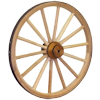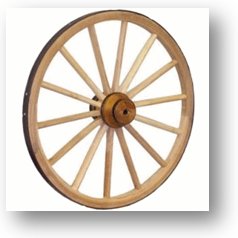Custom Wagons Wagon Wheel Hub Making
 At Custom Wagons, we build Wood Wagon Wheels, Cannon Wheels Wagon Wheel Chandeliers, Horse Drawn Wagons, Smoker Steel Wagon Wheels. BBQ Steel Wagon Wheels and Carriage-Buggy Wheels. For a complete list of our products, please check out website.
At Custom Wagons, we build Wood Wagon Wheels, Cannon Wheels Wagon Wheel Chandeliers, Horse Drawn Wagons, Smoker Steel Wagon Wheels. BBQ Steel Wagon Wheels and Carriage-Buggy Wheels. For a complete list of our products, please check out website.
What I know about Wagon Wheel Making, by M.T. RichardsonIn 1892, M.T. Richardson did a two volume work entitled Practical Carriage Building. This two volume work is perhaps the most complete and accurate contemporary work on the subject. Not a lot has changed in the making of wagon wheels in the past 120 years since Richardson wrote this, we still build Yesterdays Handmade Wagon Wheels, Handmade in the USA Today. We have included a part of Richardson's information on Wagon Wheel Making so that our customers might understand some of the process and expertise that is needed to build their wagon wheels.
My idea of what a good wheel should be is this: First, the timber of which the wheel is built must be first-class and well seasoned. No other kind would pass muster with me. It is of as much importance that the timber should be well seasoned as that it should be good. No matter how good a workman may be, he never can make a good wheel out of unseasoned timber. If the wheels—say a farm wagon—are to be well made, the forward wheels should be straight across the face. What I mean is, that if a straight edge is held across the face of the wheel, it should touch the base of the spokes, and also both sides of the rim. That is what is called a wheel straight on its face, without any dish. For the hind wheels I think barely one-eighth of an inch dish is enough, before the tire is set. If the felloes of the wheels set well down on the shoulders of the spokes, and the felloes—if cut ones—are close jointed only between two of them, and only about an eighth of an inch there, the wheel, if the tire is set as it should be, ought to have about one-eighth of an inch dish in the forward wheel and a quarter of an inch in the hind one. I think that is plenty of draft for the first time. Much depends upon the wheels. How much draft must be given, only experience can determine; but I claim half an inch draft for the forward wheels and three-eighths for hind ones, when the tire is cold, is enough. The experienced smith knows how much to allow without cooling the tire. If, when he 'runs' the tire, the weld is at a white heat, he allows less; if at a dull red, then a little more. Before the smith sets the tire, he ought to see that one of the spokes stands above the rim, for if he does not attend to this, he is sure to get more dish in the wheel than he expected. Never put the weld of a tire opposite the open joint of a wheel, but always in the middle of the felloe. I think the notion is quite prevalent among wheel makers and users of wheels that plenty of dish fills the all-important condition of safety. Now, I think just enough dish to prevent the possibility of the spokes turning back from their angular position to a vertical one, is all that is necessary; and the better the wheel is constructed, the less liability there is of it turning back or inside out. I think some wheels turn back because they were not originally properly constructed. For my part I think no forward wheel ought to have more than five-eighths of an inch dish, and there should be no more than three-quarters of an inch in the hind wheel. After the wheels get that amount of dish in them, the tire cannot be made tight. You simply pull the spokes over, and as soon as the tension is out of them, the tire will come loose again. And it is also very certain that, after the dish is reached, the tire will dish the wheel very much more than before, for it is a well known fact that when the spokes are once bent or kinked, they never can be made straight again. Undoubtedly many wheels are made too straight; that is to say, they are about the same at the back as they are in front. As a rule you never can put any dish in such wheels, and unless the tire is always kept tight, the wheel will always turn back; and if the vehicle is heavily loaded and the wheels drop into a deep rut, they often break by being turned inside out, or rather inside in. I have seen many such wheels. Some of our most prominent manufacturers of carriages and Wagons practice the system of gouging or cutting out the ends of the spoke tenons below the surface of the rim, in order that the tire, when shrunk on, may draw the rim well up against the shoulder of the spokes, which, if the spokes were not cut out, would tend to kink or bend them. This is not so practical a theory as it may at first seem. It should be borne in mind that because the tire has dished a wheel considerably, it does not follow that the joints and shoulders arc well drawn together. Neither does it prove that the tire is on very tight, for as soon as the spokes lose their tension by being drawn over by the tire, the latter may be found very loose on the rim.In my opinion there is no surer way to dish a wheel than to let the spokes stand above the felloes when the tire is set. I have seen tire set without cutting out the ends of the spokes below a level with the rim, and afterward I could see daylight between the tire and the rim, almost between every two spokes; and the spokes were bent badly. There are times when it is very difficult to determine how much draft to give a wheel without spoiling it. If the spokes are loose in both the hub and the rim, it is almost impossible to know how much dish you can give the wheel; and I have frequently seen such wheels. It is not possible for me to say how much draft to give a reset tire, for frequently you cannot give the same amount of draft to every tire on a vehicle. I have not the least doubt that there are more wheels spoiled by ignorant blacksmiths than by wear or tear. There are times when tires come loose from new wheels almost immediately after the vehicle is put to use, and then the blacksmith is always blamed for not doing his work well. It is likely that such things are sometimes owing to one or two of the following reasons: A manufacturer of wagons or carriages may from some circumstance—for instance a larger demand than usual—run out of well seasoned wheel timber. When this happens he has to depend on the timber merchant and take the best he can get. He may be assured the timber is well seasoned; but it may not be true. Suppose he makes up his wheels from this timber, and they shrink; it is clear that the tire will come loose, and nothing the blacksmith can do will prevent it. Now here is another supposition; I know that such things have been, that wheels are made from the best of timber, well seasoned, and the workmanship without a fault. When the vehicle is first put in use—it may be weeks or months— it is run in mud or slush every day, and in spite of the painting, the felloes of the wheels will absorb moisture; they will swell very much, if they do, and as the tire is rigid, the felloes are pinched. Now let us suppose another case. A very hot and dry spell follows a wet one. It is certain that the felloes will shrink and that the tire will be loose on the wheels. Whenever these things happen the tires ought to be reset immediately; but in many instances they are not. Instead the owners wait for another wet spell to swell the felloes up again. It is possible that some one may say that a newly painted wheel will not swell in the way I describe; but it must be borne in mind that moisture is always very penetrating, and that there is no paint between the rim and the tire. If any one wishes to see how the swelling of wood may affect a wheel, let him get a new barrel, made out of the best of seasoned wood, and made by the best cooper he can find, and have the barrel hooped with six or eight strong iron bands. Then let him fill the barrel with wine, vinegar, brine, or even water, and let the liquid stay in the barrel for eight or ten weeks; then empty the barrel and let it stand in the sun for two or three weeks. He will then perceive that both heads and all the staves have shrunk. The wood swelled and was then pinched, because the hoops were unyielding. I contend that the principle is the same both in barrel and wheel. It seems to enter the thoughts of but few wheel owners that loose tires do the wheel great harm. When the tire is loose and the vehicle is run in sandy roads, the sand gets between the tire and the rim of the wheels, and grinds the felloes away very quickly, to say nothing of loosening the spokes in the rim. The consequence often is that, when the wheels can go no longer without the tire being reset, some thoughtless or careless blacksmith sets the tire without cutting down the spokes level with the rim, and so dishes and spoils the wheels. This is done repeatedly. I have often been asked to make the tire very tight; but those who advised this did not know they were asking me to shorten the life of the wheels. Beyond a certain point you cannot tighten the tire; you simply sink the tires into the felloes and bend the spokes. I believe in having the joints of the rim somewhat higher, but do not believe in a perfect joint there. I have noticed that when a perfect joint has been made, by the time the tire needed resetting, there was a small opening inward, which, in spite of the bolts and felloe clips, got larger, until the rim sagged down at the joints. But by leaving the joints a little open outward, the tendency to sag is corrected. Nothing weakens or disfigures a wheel more than to have it sag at the joints." ©Copyright www.customwagons.com All Rights Reserved |
Main Site
Home
Abraham Lincoln Hearse
Cannon Wheels
Customer Comments
Custom Wagons
Buggy - Carriage Wheels
Electric Carriage
Steel Wagon Wheels
Wagons, Full Size
Wagon Wheel History
Wooden Wagon Wheel Chandeliers
Wood Wagon Wheels
Wood Buckets - Butter Churns
Custom Wagons Resources
Products & Services
Custom Wagons Contact & Help
Privacy Policy
Sending Us A Payment
Shipping Questions
 I fully believe that a first-class wheel can be produced only by the most judicious exercise of mechanical skill. It is the combination of seemingly simple and trifling things which makes all the difference between a good and a bad wheel. But nevertheless it is a well known fact that many poor wheels are made. I will go further and say that a good wagon wheel cannot be made unless the timber of which it is constructed is first-class. No amount of good workmanship can make amends for the lack of good material. It is no exaggeration to say that there are many more poor wagon wheels than good ones. Most wagon smiths know that all wheelwrights are not masters of their trade. Of what good is a vehicle if its wheels are defective? There is a well-known and trite saying, "No wheels no wagon."
I fully believe that a first-class wheel can be produced only by the most judicious exercise of mechanical skill. It is the combination of seemingly simple and trifling things which makes all the difference between a good and a bad wheel. But nevertheless it is a well known fact that many poor wheels are made. I will go further and say that a good wagon wheel cannot be made unless the timber of which it is constructed is first-class. No amount of good workmanship can make amends for the lack of good material. It is no exaggeration to say that there are many more poor wagon wheels than good ones. Most wagon smiths know that all wheelwrights are not masters of their trade. Of what good is a vehicle if its wheels are defective? There is a well-known and trite saying, "No wheels no wagon."


